AI leaders are seeing 20–30% productivity gains and an average 3.7x ROI, with top performers hitting 10x on their investments. Those wins get plenty of headlines, but here’s the catch: 74% of companies still can’t show clear business impact from AI.
Talk to any tech leader, and the same themes come up. On paper, every platform looks solid. In practice, hidden costs pop up, integrations stall, and that promised ROI turns slippery. All while you’re under pressure to pick an AI automation platform that delivers in months, scales across IT teams and business units, and doesn’t derail what already works.
At Aloa, we’ve worked with more than 250 companies facing that same pressure. Our team builds custom AI development services that fit your workflows and grow with you. We prototype fast, design for sustainable ROI, and keep things practical. No generic promises. Instead, you get tested ways to automate complex workflows, strengthen internal tools, and deliver results your team can measure.
This guide is built to make those high-stakes decisions easier. You’ll see how to compare AI automation platforms using ROI benchmarks, integration checklists, side-by-side comparisons, industry-specific factors, and rollout strategies. Each section is packed with concrete examples and actionable steps so you can make a confident call and show measurable impact.
Understanding AI Automation Platform Categories
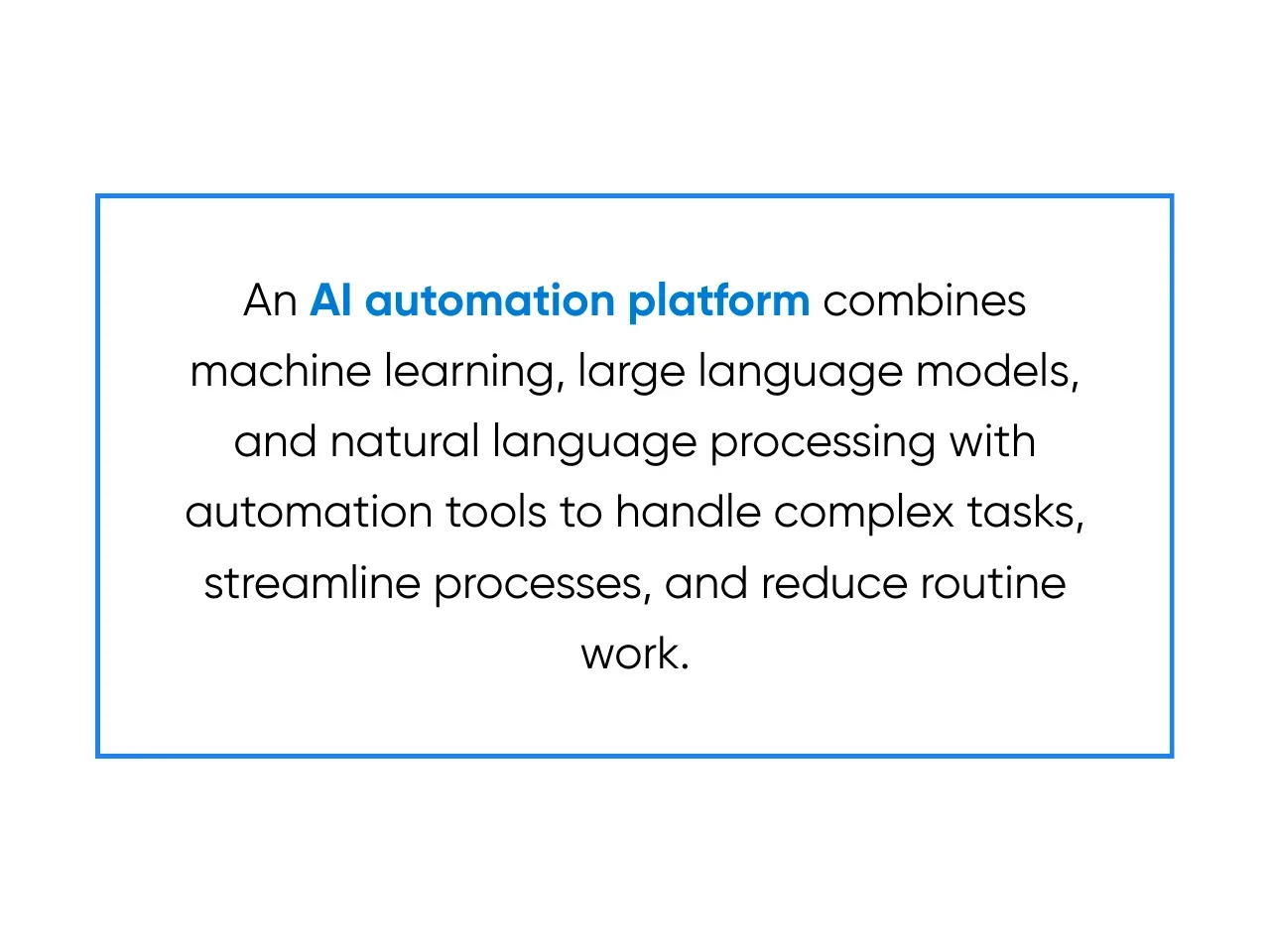
An AI automation platform combines artificial intelligence, such as machine learning, large language models, and natural language processing, with automation tools. It helps systems learn from data, handle complex tasks and business processes, and take routine work off your team members' plates.
Knowing the main categories helps you match solutions to real business needs and set ROI targets you can hit. The four you’ll see most often are:
Workflow Automation Platforms
These platforms connect different apps and trigger actions automatically when conditions are met. They cut manual work so your team can focus on specific tasks and higher-impact projects.
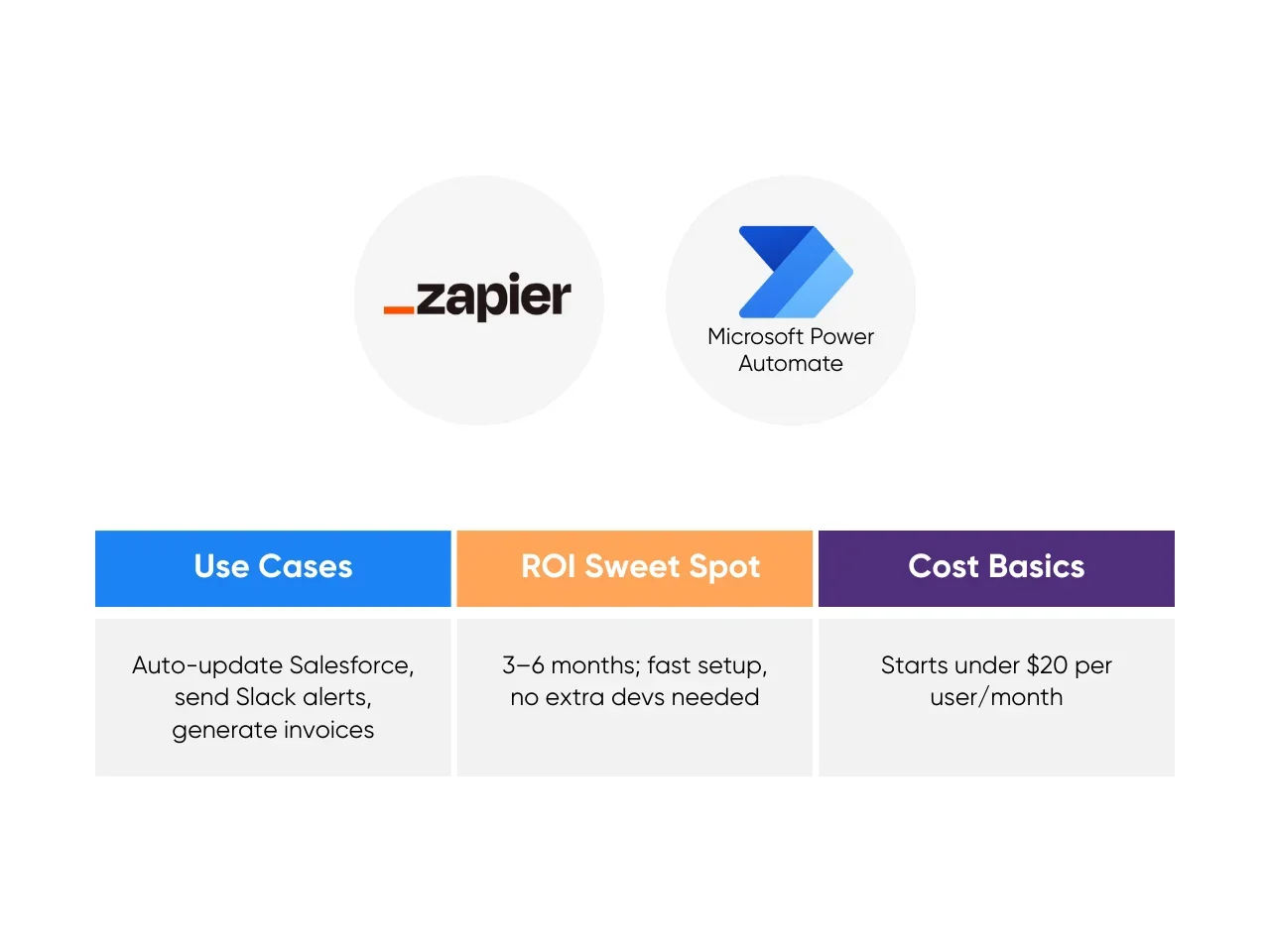
A 2024 Forrester study on Microsoft Power Automate found that many companies made back their investment in under six months. Even a couple of targeted automations, like syncing orders or routing approvals, can save hundreds of staff hours each year.
Intelligent Document Processing
IDP tools extract and organize data from PDFs, scans, and forms. They reduce data entry errors and speed up compliance-heavy tasks.
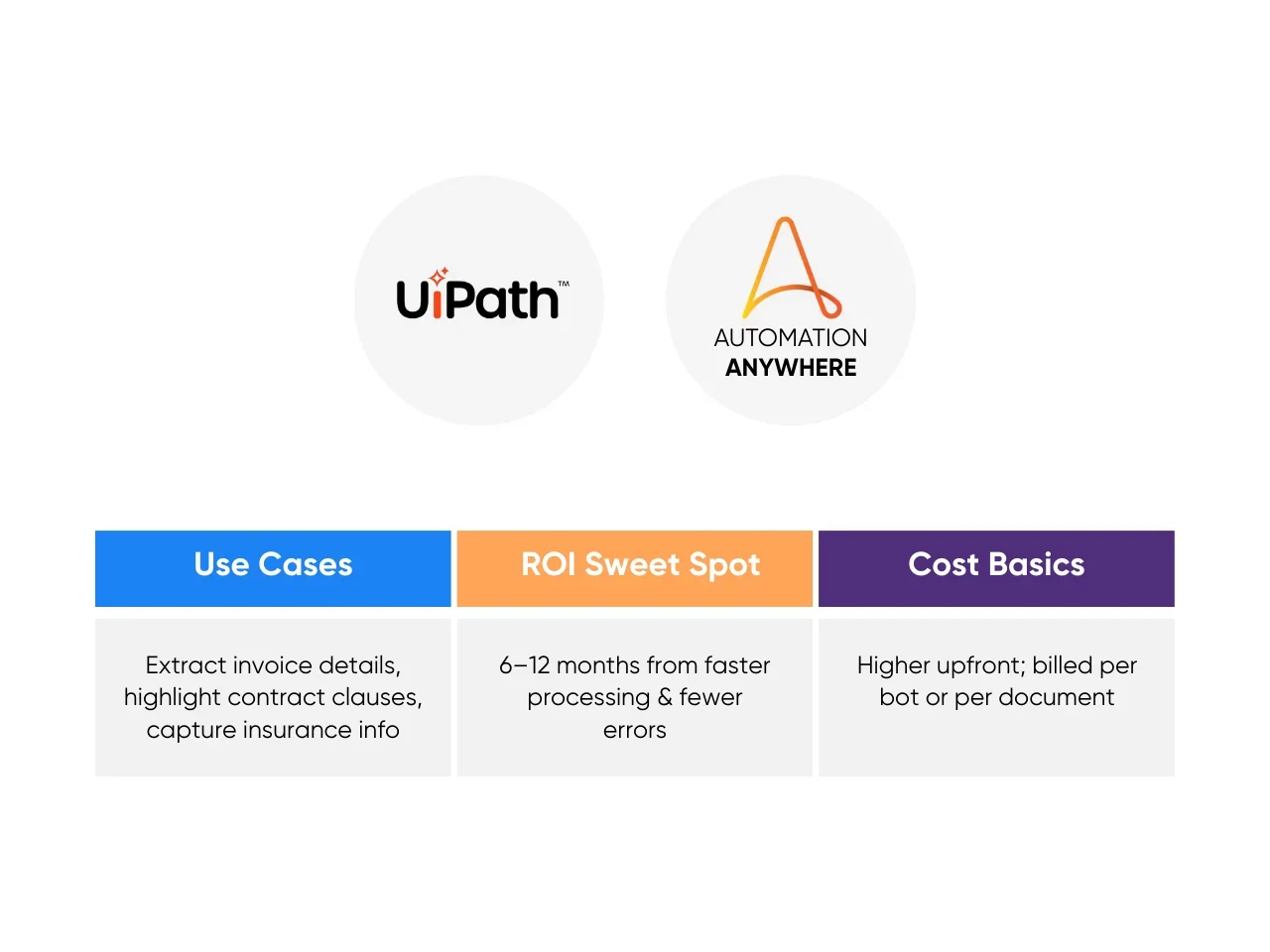
UiPath reports IDP can cut document handling time by up to 70% for invoice processing. Industry studies confirm this: tasks that used to take 30 minutes manually now finish in under five. These gains have been documented in banking and healthcare teams that process large volumes of forms.
Conversational AI Platforms
These platforms handle everyday customer support or employee questions through AI chatbots or voice assistants. When designed well, they deliver quick answers with less human intervention while your team focuses on more complex issues.
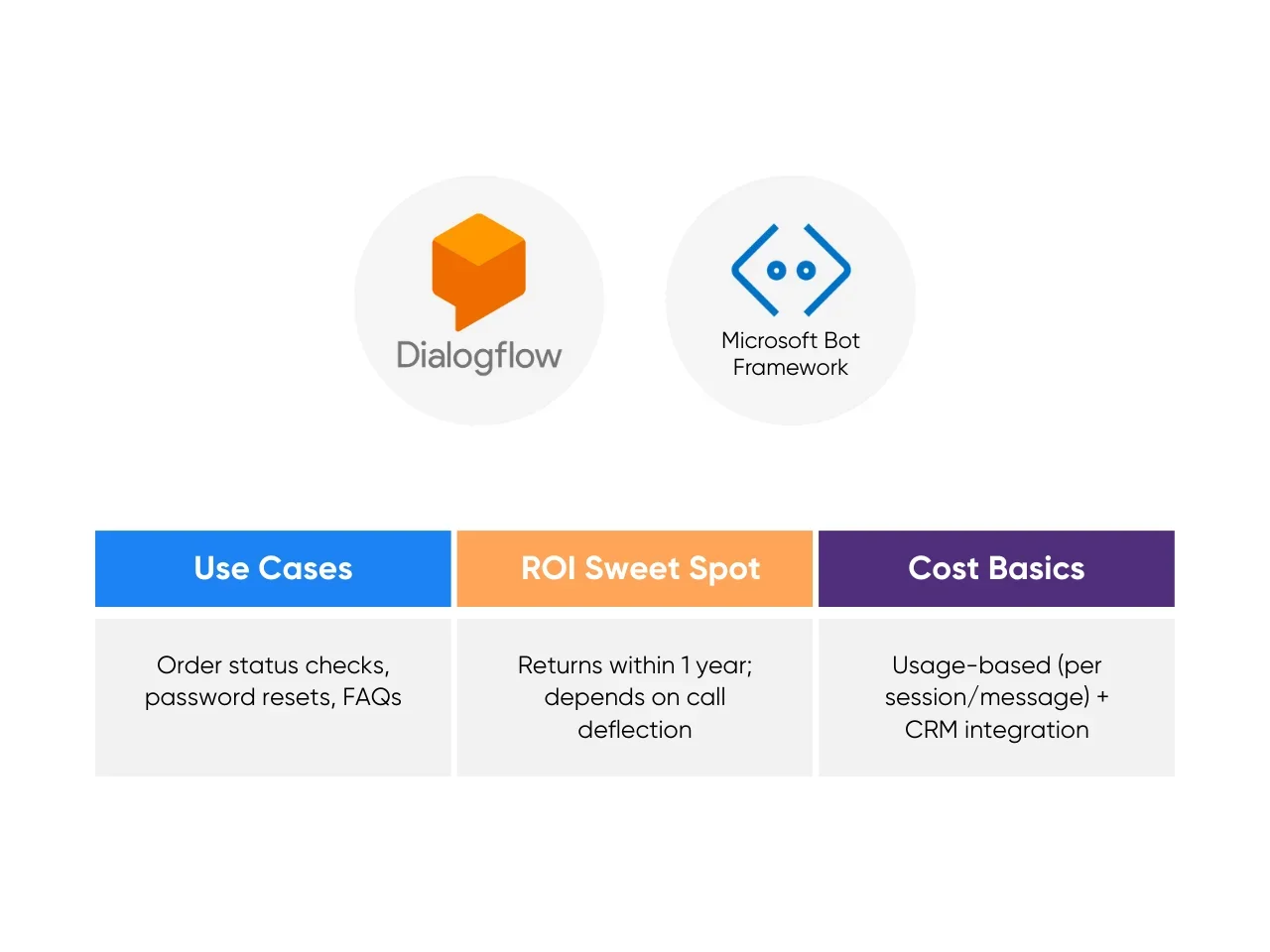
Companies exploring interactive AI business integration often describe conversational AI as one of the most visible ROI plays because you can see ticket volumes drop and response times improve in real metrics.
Predictive Analytics Platforms
These platforms use machine learning to forecast outcomes and recommend actions. They help teams act earlier and plan with better data.

H2O.ai highlights how predictive maintenance cuts downtime by spotting issues early. Retailers using demand forecasts report fewer stockouts and better margins. Manufacturers document fewer emergency repairs.
Choosing the right category early helps you avoid wasted money and makes vendor comparisons later far easier. Check our guide to the best free AI tools for more ideas on tools across these categories.
ROI Analysis Framework for AI Automation Platforms
Our framework combines hard savings, soft benefits, and full cost accounting so you can make an apples-to-apples comparison between platforms:
Quantitative ROI Metrics
You can measure the ROI consistently across vendors using this formula:
- Start with Baselines: Document how long key tasks take today and the error rates. Track data for at least one full cycle (e.g., monthly or quarterly).
- Standard ROI Formula for Automation Projects:

- Direct Savings Categories:Labor Cost Reduction: Hours saved × fully loaded hourly rateError Elimination: (Baseline error count – post-automation error count) × average cost per error (including rework or fines)Speed Improvements: Value of faster throughput; e.g., extra invoices processed per month without new staff.
- Labor Cost Reduction: Hours saved × fully loaded hourly rate
- Error Elimination: (Baseline error count – post-automation error count) × average cost per error (including rework or fines)
- Speed Improvements: Value of faster throughput; e.g., extra invoices processed per month without new staff.
- Data Tracking Template:Baseline: manual hours per task, number of errors, average task cycle time.Post-Implementation: measure at 6, 12, and 24 months to confirm sustained gains.
- Baseline: manual hours per task, number of errors, average task cycle time.
- Post-Implementation: measure at 6, 12, and 24 months to confirm sustained gains.
Qualitative Benefit Assessment
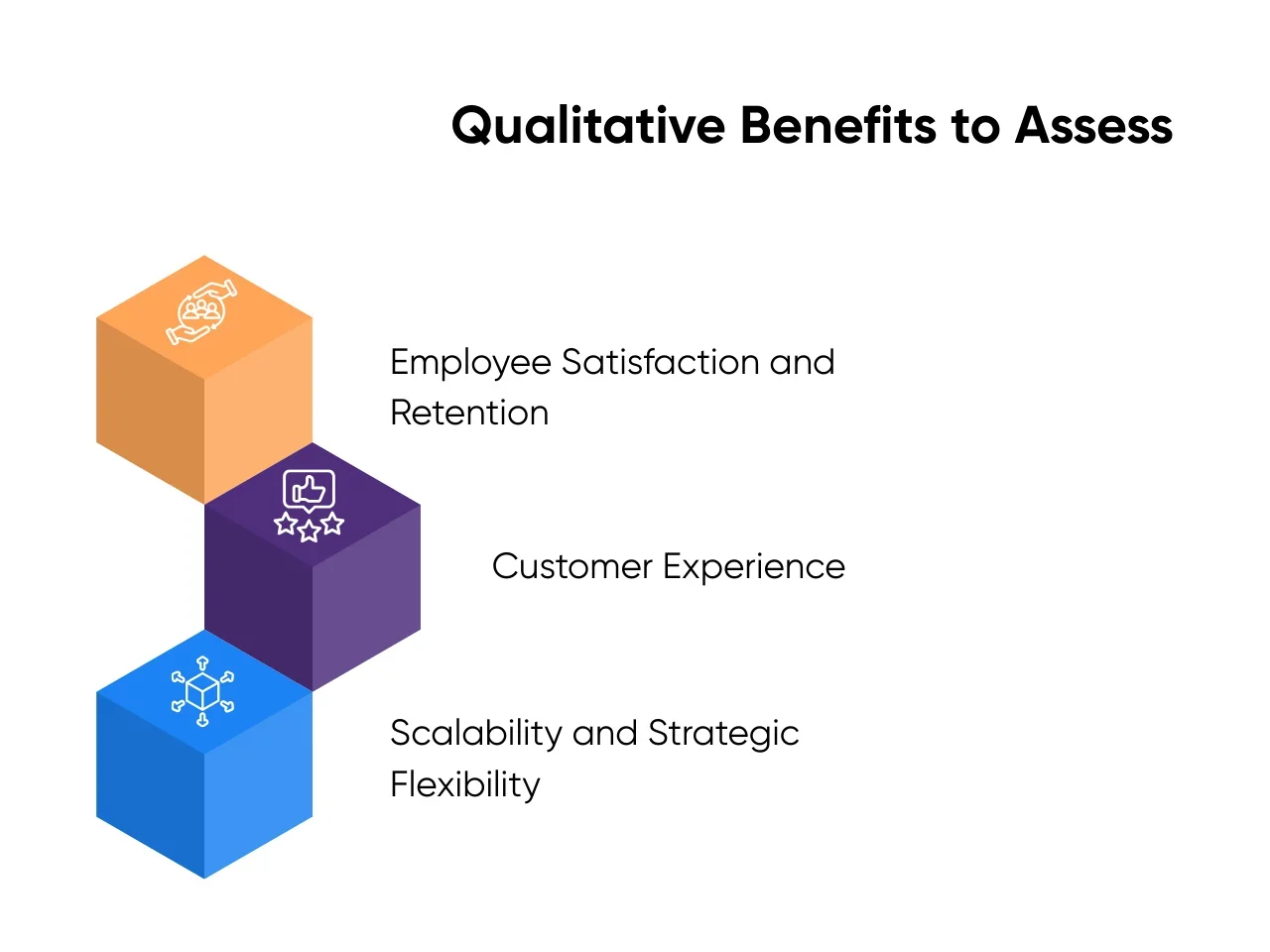
Some outcomes aren’t easy to measure but can still matter, such as:
- Employee Satisfaction and Retention: Use quarterly surveys to track satisfaction before and after rollout. Estimate turnover cost savings (recruiting, onboarding) if retention improves.
- Customer Experience: Faster response times improve NPS (Net Promoter Score) and retention. Link NPS improvements to lifetime customer value for a dollar estimate.
- Scalability and Strategic Flexibility: The ability to add new workflows without proportional cost. Compare capacity (e.g., invoices handled per FTE) pre- and post-automation.
To assign dollar values:
- Benchmark against industry averages: A 5–10% retention gain can save $50K+ annually for mid-sized teams, based on SHRM estimates of $10K–$20K per turnover event.
- Use customer lifetime value formulas to link improved experience scores to revenue retention.
- Compare performance to peer benchmarks; many vendors like Zapier publish use-case ROI examples.
Pairing these soft benefits with your hard-savings formula gives a more realistic view of the platform’s total impact.
Implementation Cost Analysis

Try to build a complete picture of your ROI by including costs associated with:
- Licensing and Subscriptions: Most platforms are SaaS. Costs scale with users, workflows, or data volume.
- Integration: API development, connecting legacy systems, and data cleanup.
- Training and Change Management: Staff onboarding, internal champions, and any downtime during rollout.
- Maintenance and Support: Ongoing vendor fees, model retraining, and updates.
Some hidden costs to watch for are:
- Customization needs beyond out-of-the-box features.
- Temporary productivity dips during the adoption curve.
- Opportunity cost if other projects get delayed for the rollout.
Integration Capabilities Assessment
Successful integration depends on API quality, security, data compatibility, scalability, and support. Score the platform on each to see if it works with your systems and to keep the evaluation as objective as possible across vendors.
Technical Integration Requirements
Here are the technical elements you should review:
- API Quality:Is the API well-documented with clear examples?Does it support modern REST or GraphQL standards?Are SDKs available for your primary languages (Python, JavaScript)?
- Is the API well-documented with clear examples?
- Does it support modern REST or GraphQL standards?
- Are SDKs available for your primary languages (Python, JavaScript)?
- Authentication and Security:Does it offer secure methods like OAuth 2.0?Can you enforce multi-factor authentication for sensitive workflows?
- Does it offer secure methods like OAuth 2.0?
- Can you enforce multi-factor authentication for sensitive workflows?
- Data Handling:Does it support the formats you use (JSON, XML, CSV)?Are there built-in data transformation tools to map fields between systems?
- Does it support the formats you use (JSON, XML, CSV)?
- Are there built-in data transformation tools to map fields between systems?
- Processing Modes:Does it handle real-time triggers via webhooks, or is it batch-only?What’s the average latency for event processing?
- Does it handle real-time triggers via webhooks, or is it batch-only?
- What’s the average latency for event processing?
- Scalability and Reliability:Are there rate limits that might throttle you as volume grows?How does the platform handle retries and error logging?Is monitoring available (dashboards, alerts) for integration health?
- Are there rate limits that might throttle you as volume grows?
- How does the platform handle retries and error logging?
- Is monitoring available (dashboards, alerts) for integration health?
Spending time on this upfront helps you avoid issues like unexpected rate-limiting or unplanned middleware later.
Security and Compliance Evaluation
You’ll also need to confirm that the platform meets your security and compliance requirements. Integration isn’t just about connecting systems; it’s also about protecting sensitive data and following regulations.
Focus on these security and compliance aspects:
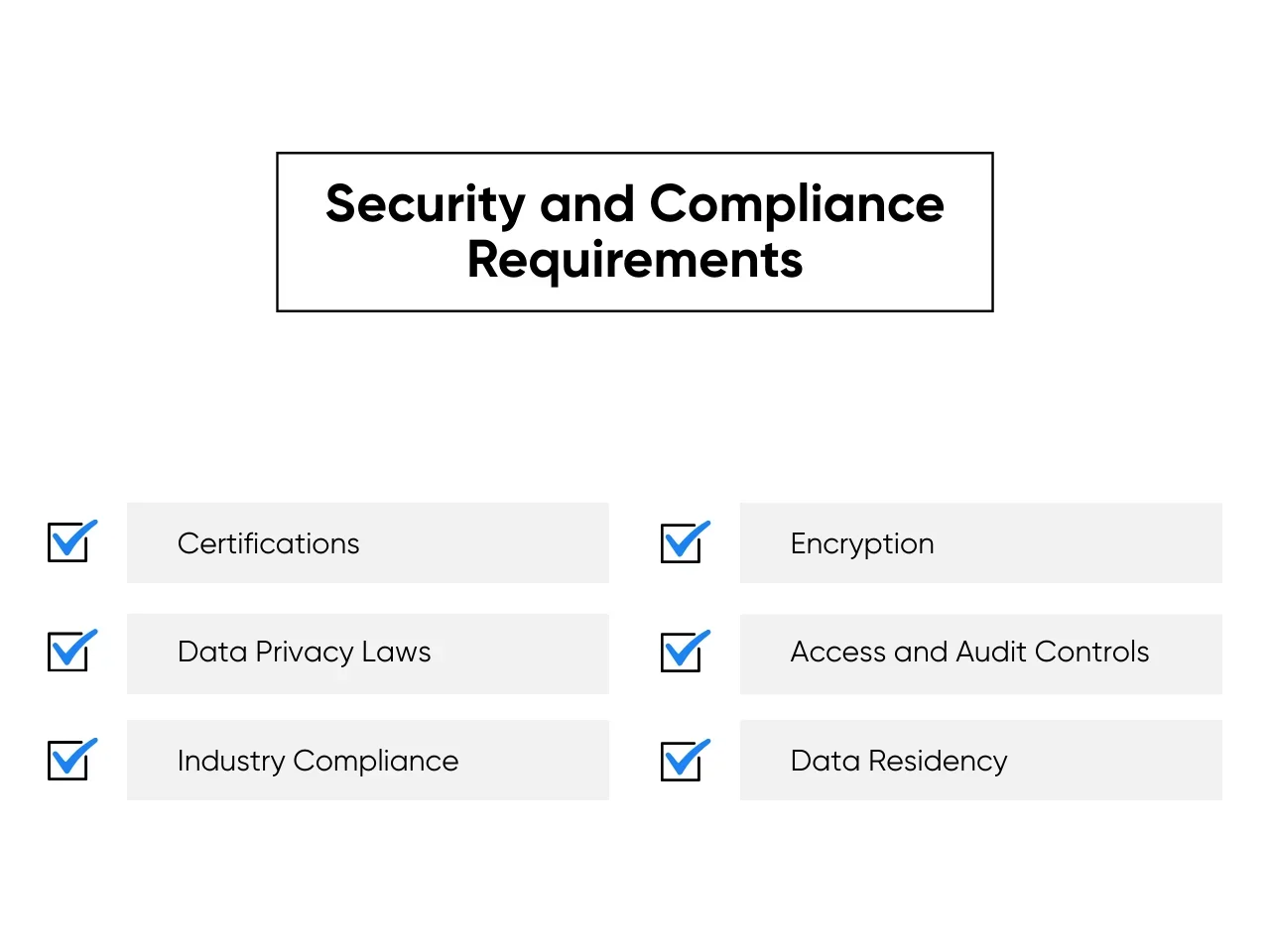
- Certifications: Does the vendor have SOC 2 Type II, ISO 27001, or equivalent audits?
- Data Privacy Laws: Can they support GDPR and CCPA requirements like right-to-erasure requests?
- Industry Compliance:HIPAA for healthcare dataPCI-DSS if handling credit cards
- HIPAA for healthcare data
- PCI-DSS if handling credit cards
- Encryption:Is data encrypted at rest (AES-256 or similar)?Is TLS 1.2+ used for data in transit?
- Is data encrypted at rest (AES-256 or similar)?
- Is TLS 1.2+ used for data in transit?
- Access and Audit Controls:Can you define role-based access for API keys and dashboards?Are audit logs available for all admin actions?
- Can you define role-based access for API keys and dashboards?
- Are audit logs available for all admin actions?
- Data Residency:Can you control where data is stored and processed (important for EU clients)?
- Can you control where data is stored and processed (important for EU clients)?
Ask vendors for their security whitepapers or recent penetration testing results. Confirm they support single sign-on (SSO) and granular permissions for added control.
Change Management and Adoption
Finally, consider how the platform rollout will impact users and workflows. Even the best technical fit can fail if employees don’t adopt it.
To make adoption smoother and minimize disruption, you should:
- Invest in Training: Identify super-users in each department to pilot the tool and train others. Run hands-on workshops instead of relying only on documentation.
- Plan Phased Rollouts: Begin with one or two high-impact AI automation use cases that will significantly benefit your business. Gather feedback, fix issues, and expand gradually.
- Secure Stakeholder Buy-in: Share pilot results and ROI forecasts early with leadership and department heads. Use quick wins to build momentum.
- Mitigate Workflow Disruption: Anticipate short-term productivity dips. Prepare fallback processes or rollback plans in case of major issues.
- Measure Adoption: Use surveys to gauge satisfaction and track metrics like usage rates, error reduction, and time savings.
People on /r/automation reported that phased rollouts with early champions increase adoption rates and minimize pushback.
Scoring Framework to Compare Vendors
Use a 1–5 scale to rate each platform on each area based on your answers to the rubric questions above:
- API and Documentation Quality
- Data Format Compatibility
- Security Certifications and Controls
- Scalability Under Load
- Vendor Support and Training Quality
This gives you a quantifiable basis for comparing integration complexity and likelihood of success across vendors, instead of relying on gut feel.
Top Enterprise AI Automation Platforms Compared
Selecting the right AI automation platform depends on more than features. McKinsey's State of AI survey shows that the companies really killing it with AI are the ones customizing solutions around their specific business needs and data. HBR's take on enterprise AI adoption backs this up: ROI gets way better when you actually plan things out and align everything strategically.
Let’s break down the best AI automation tools to see where each platform excels, how long ROI typically takes, and what integration demands look like:
Microsoft Power Platform
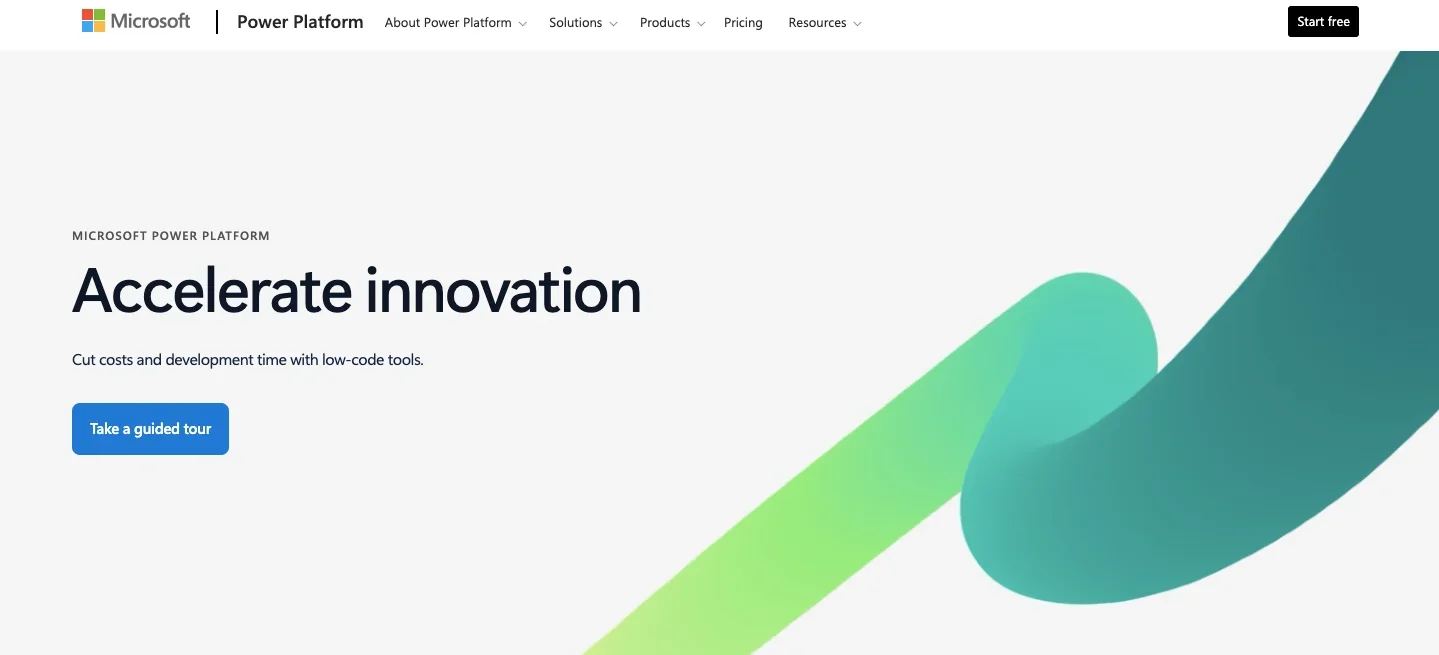
For companies already using Office 365 and Azure, Microsoft’s Power Platform (Power Automate, Power Apps, Power BI) often gives the fastest payoff because of its native Microsoft connections.
- Strengths:Built-in connectors for Office 365, Dynamics, Teams, SharePoint, plus hundreds of SaaS apps.Enterprise security built on Azure AD; SOC 2, ISO 27001, and GDPR support included.Low-code environment lets business teams build and tweak flows without waiting on IT backlogs.
- Built-in connectors for Office 365, Dynamics, Teams, SharePoint, plus hundreds of SaaS apps.
- Enterprise security built on Azure AD; SOC 2, ISO 27001, and GDPR support included.
- Low-code environment lets business teams build and tweak flows without waiting on IT backlogs.
- Limits:Advanced automations still need trained Power Platform developers.Integration with non-Microsoft systems may need custom APIs or middleware.
- Advanced automations still need trained Power Platform developers.
- Integration with non-Microsoft systems may need custom APIs or middleware.
- Pricing: Per-user or per-flow plans; starts around $15–$40 per user/month. Enterprise bundles available with Office 365 E5.
- ROI Benchmarks: Forrester’s 2024 TEI study reported an average 216% ROI over three years, a net present value of $93 million, and payback in under six months for many deployments. Teams combining low-code with traditional dev saw 35% faster development cycles and up to 25% employee time savings. Some enterprises reported an additional $15M+ in revenue through faster custom app launches.
- Integration Complexity Score:2/5; smoothest for Microsoft environments, moderate if integrating with non-Microsoft stacks like Salesforce or SAP.
Teams often use Power Platform to automate compliance reporting by pulling live data into Power BI dashboards, connect Teams approvals with Dynamics 365 sales orders, and archive legal documents from Outlook to SharePoint for audits.
UiPath
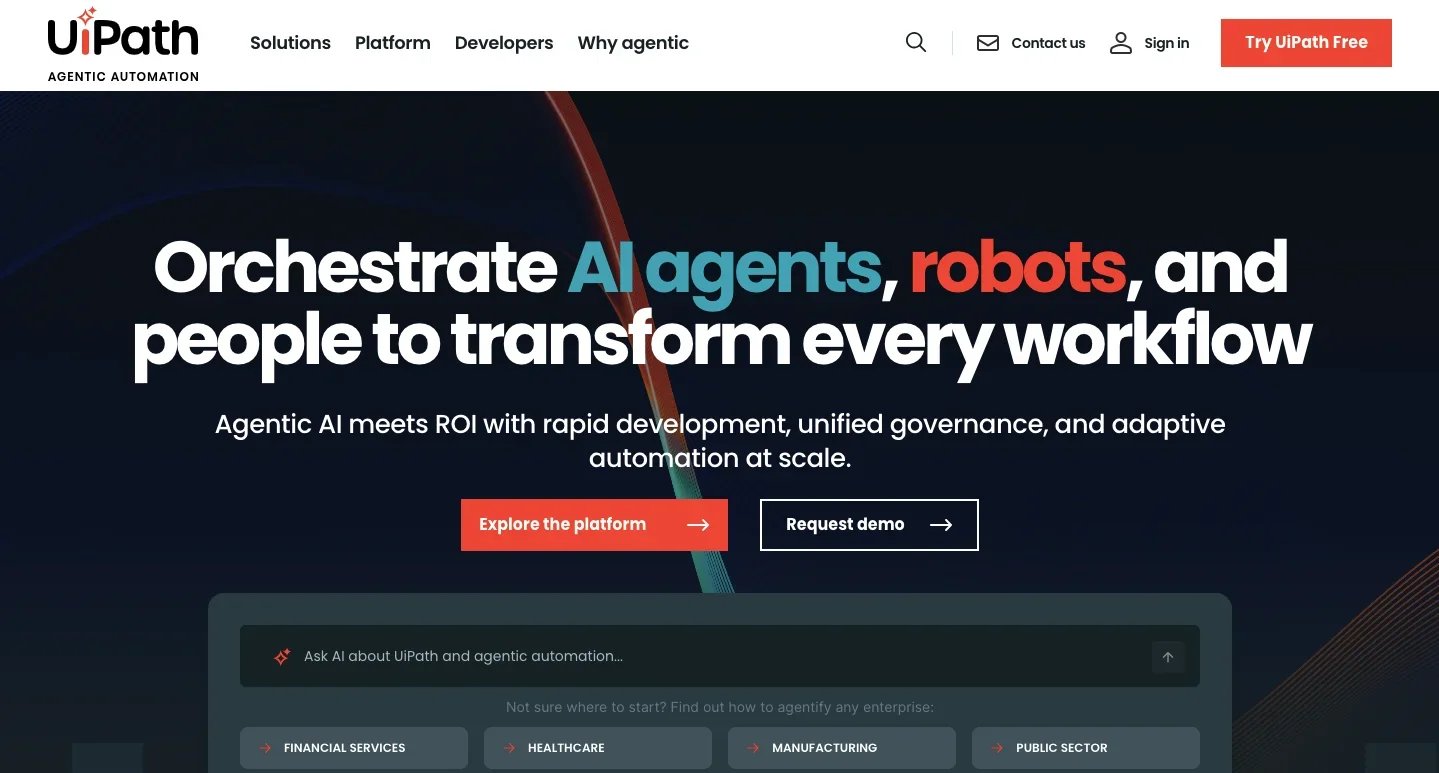
UiPath leads in robotic process automation and has expanded into AI modules for tasks like document understanding and model orchestration.
- Strengths:Bots handle repetitive work in systems without APIs, including desktop apps and legacy ERPs.AI add-ons like Document Understanding and ML model integration support high-volume document tasks.Proven ability to scale across global teams with governance controls.
- Bots handle repetitive work in systems without APIs, including desktop apps and legacy ERPs.
- AI add-ons like Document Understanding and ML model integration support high-volume document tasks.
- Proven ability to scale across global teams with governance controls.
- Limits:Needs RPA developers; not a self-service tool for most business users.Higher infra and licensing costs versus SaaS-only tools.
- Needs RPA developers; not a self-service tool for most business users.
- Higher infra and licensing costs versus SaaS-only tools.
- Pricing: Enterprise licensing; per-bot and per-user fees; higher upfront cost but predictable at scale.
- ROI Benchmarks: UiPath customers automating high-volume tasks like claims processing typically see 6–12 month payback, and 12–18 months for multi-department enterprise rollouts. Its AI modules achieve 85% document processing accuracy with cognitive bots showing close to 90% success rates for complex decision-making. Bot development time has dropped 70% with AI assistance, which improves speed to value.
- Integration Complexity Score:3/5; moderate to high due to legacy ERP/CRM integration and infrastructure needs.
Companies adopt UiPath to automate insurance claims by extracting data from PDFs into mainframe systems, reconcile invoices across multiple ERPs, or schedule overnight desktop jobs without manual monitoring.
Zapier
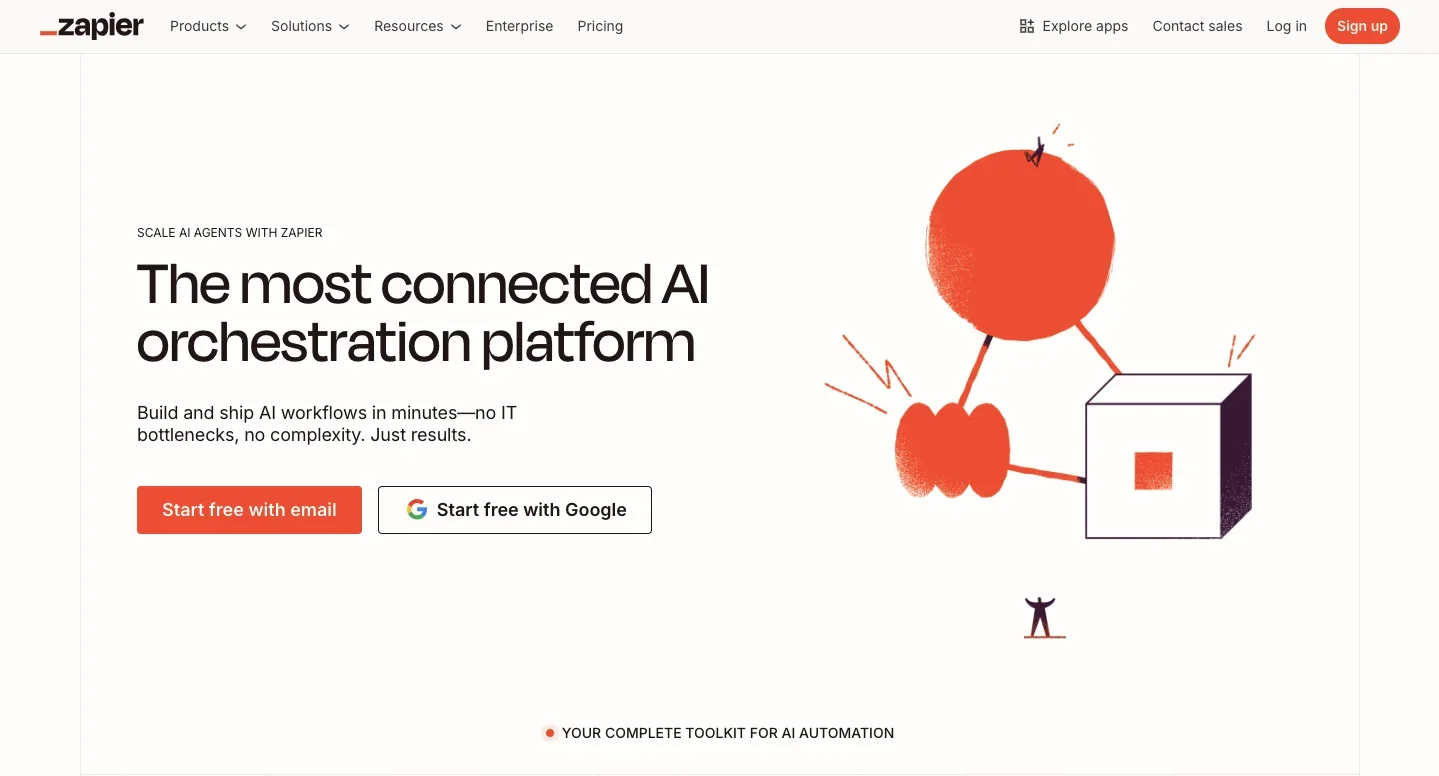
Zapier excels at ease of use and quick deployment, making it a favorite for SMBs and mid-market teams without heavy IT support.
- Strengths:Over 6,000 app integrations; set up automated “Zaps” between CRMs, marketing tools, and project software.No-code drag-and-drop interface lets non-technical staff create automations quickly.Excellent documentation and community support; new integrations added frequently.
- Over 6,000 app integrations; set up automated “Zaps” between CRMs, marketing tools, and project software.
- No-code drag-and-drop interface lets non-technical staff create automations quickly.
- Excellent documentation and community support; new integrations added frequently.
- Limits:Less suited for complex, multi-step enterprise workflows; rate limits on lower plans.Not ideal for regulated industries due to limited enterprise-grade compliance.
- Less suited for complex, multi-step enterprise workflows; rate limits on lower plans.
- Not ideal for regulated industries due to limited enterprise-grade compliance.
- Pricing: Free tier available; paid plans start at ~$20/month; Zapier for Teams adds shared folders, SSO, and advanced admin controls.
- ROI Benchmarks: Zapier’s simplicity drives near-instant time-to-value. Typical teams save 30 seconds per task step (roughly 75+ hours a year), which translates to 30x ROI on entry-level plans. Break-even often happens within 2–4 hours of automation use, with many small teams seeing measurable gains in weeks.
- Integration complexity score:1/5; nearly plug-and-play.
It’s commonly used to sync webinar attendee lists from Eventbrite into CRMs, post e-commerce order alerts into Slack with customer details, and route new leads from Facebook Ads directly into nurture email campaigns.
Automation Anywhere
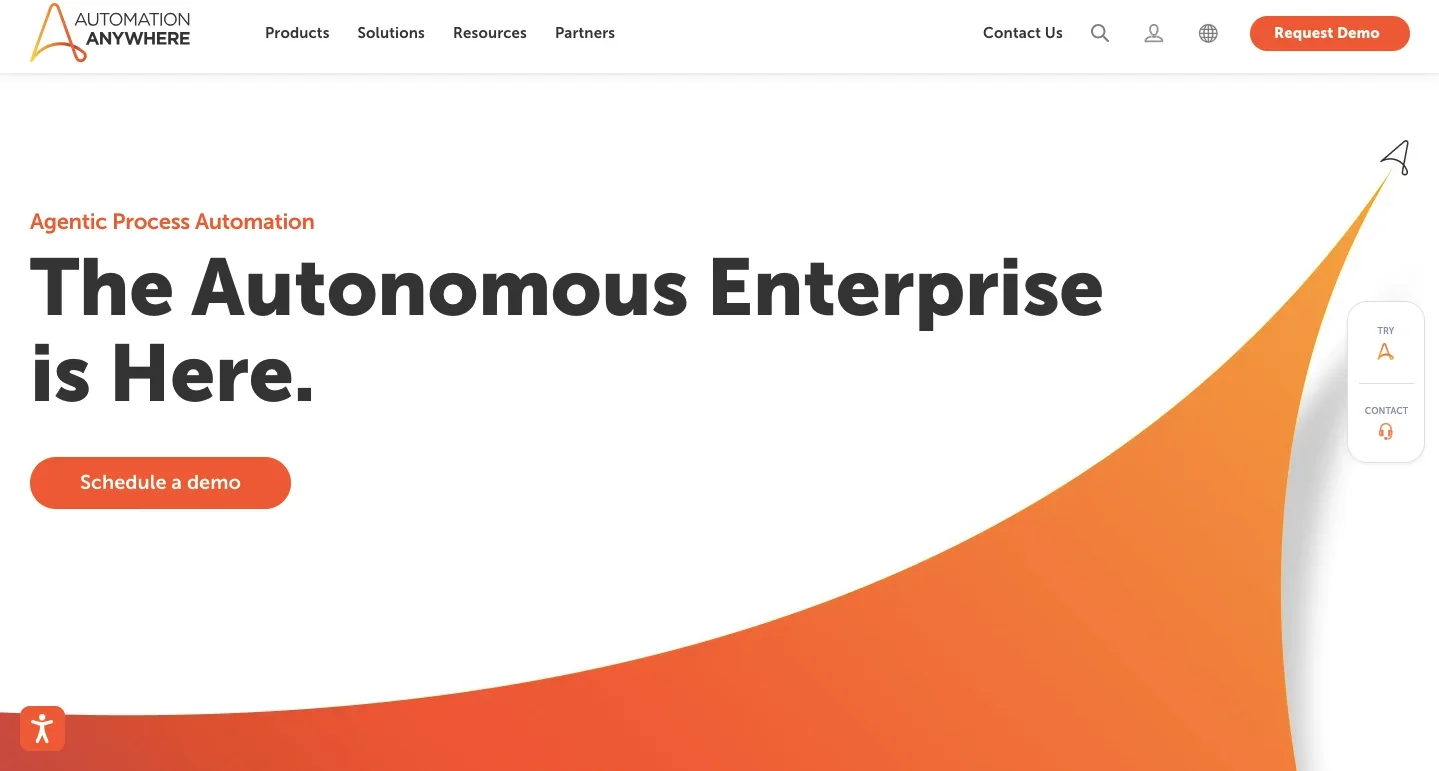
Automation Anywhere combines RPA with AI capabilities and supports cloud or on-prem deployment, appealing to regulated industries.
- Strengths:Cloud-native bots; Bot Store offers reusable components to shorten setup.IQ Bot uses AI for unstructured document processing.Vertical-specific accelerators for finance, healthcare, and supply chain.
- Cloud-native bots; Bot Store offers reusable components to shorten setup.
- IQ Bot uses AI for unstructured document processing.
- Vertical-specific accelerators for finance, healthcare, and supply chain.
- Limits:Licensing not always transparent; governance setup is critical before scaling.Steeper learning curve compared to Zapier or Power Automate.
- Licensing not always transparent; governance setup is critical before scaling.
- Steeper learning curve compared to Zapier or Power Automate.
- Pricing: Enterprise licensing; per-bot/user fees; cloud options reduce infra costs.
- ROI Benchmarks: Many mid-market deployments report 6–9 month payback, while heavily regulated, complex processes may take 12+ months. Automation Anywhere reports 75%+ license utilization in large enterprises and over 100,000 AI-powered process runs completed by customers. 70% of new bookings now come from AI automation use cases.
- Integration complexity score:3/5; moderate; easier with cloud hosting.
Firms often rely on it for automating KYC checks by pulling and validating data from multiple systems, matching purchase orders to invoices, and extracting patient data from scanned forms into EMR systems.
ServiceNow
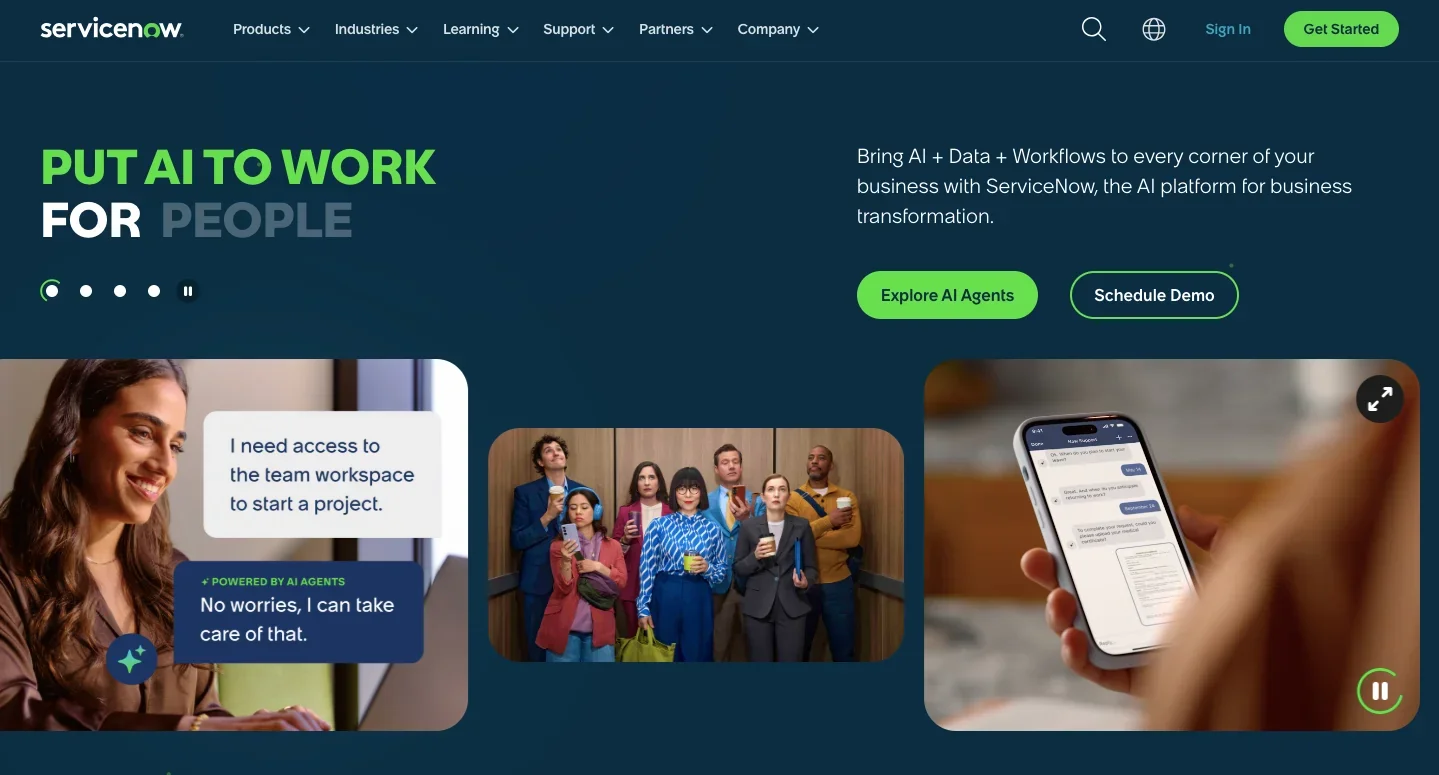
ServiceNow began as an IT service management tool but now supports enterprise-wide workflow automation with strong governance.
- Strengths:Deep ITSM integration; automates HR, finance, and ops workflows with unified audit trails.Enterprise-grade compliance; integrates with SSO and identity systems.Large ecosystem of partners and third-party modules.
- Deep ITSM integration; automates HR, finance, and ops workflows with unified audit trails.
- Enterprise-grade compliance; integrates with SSO and identity systems.
- Large ecosystem of partners and third-party modules.
- Limits:High implementation effort; requires trained admins and customization.Licensing is modular; costs rise with additional workflows and features.
- High implementation effort; requires trained admins and customization.
- Licensing is modular; costs rise with additional workflows and features.
- Pricing: Custom enterprise pricing; modular licensing; higher TCO than SaaS-only options.
- ROI Benchmarks: ServiceNow implementations often report 167% ROI with ~6-month payback for focused deployments like IT service automation. Full enterprise transformations average 9–18 months to reach payback due to their scope. Its platform supports comprehensive workflow automation across IT, HR, and compliance, with strong audit and AI governance.
- Integration complexity score:4/5; highest among compared platforms; often needs professional services.
Organizations use ServiceNow to automate IT incident routing with SLAs, coordinate HR onboarding with device and account provisioning, and manage compliance workflows with end-to-end audit logging.
How to Use This Comparison
Each platform’s ROI depends on fit, scope, and integration readiness. For example:
- Fast wins with low IT effort: Zapier or Power Platform.
- Complex, high-volume or regulated workflows: UiPath or Automation Anywhere.
- Enterprises with ITSM at the core: ServiceNow.
Pair these insights with your ROI and integration checklists from earlier. Benchmark ROI timelines (3–18 months) and integration scores (1–5) to align with your company’s risk tolerance and resources.
Industry-Specific Implementation Considerations
AI automation isn’t one-size-fits-all. Each industry has its own compliance rules, workflow pain points, and ROI expectations. Leaders weighing platforms need to keep those realities front and center. Let’s break it down by industry:
Healthcare
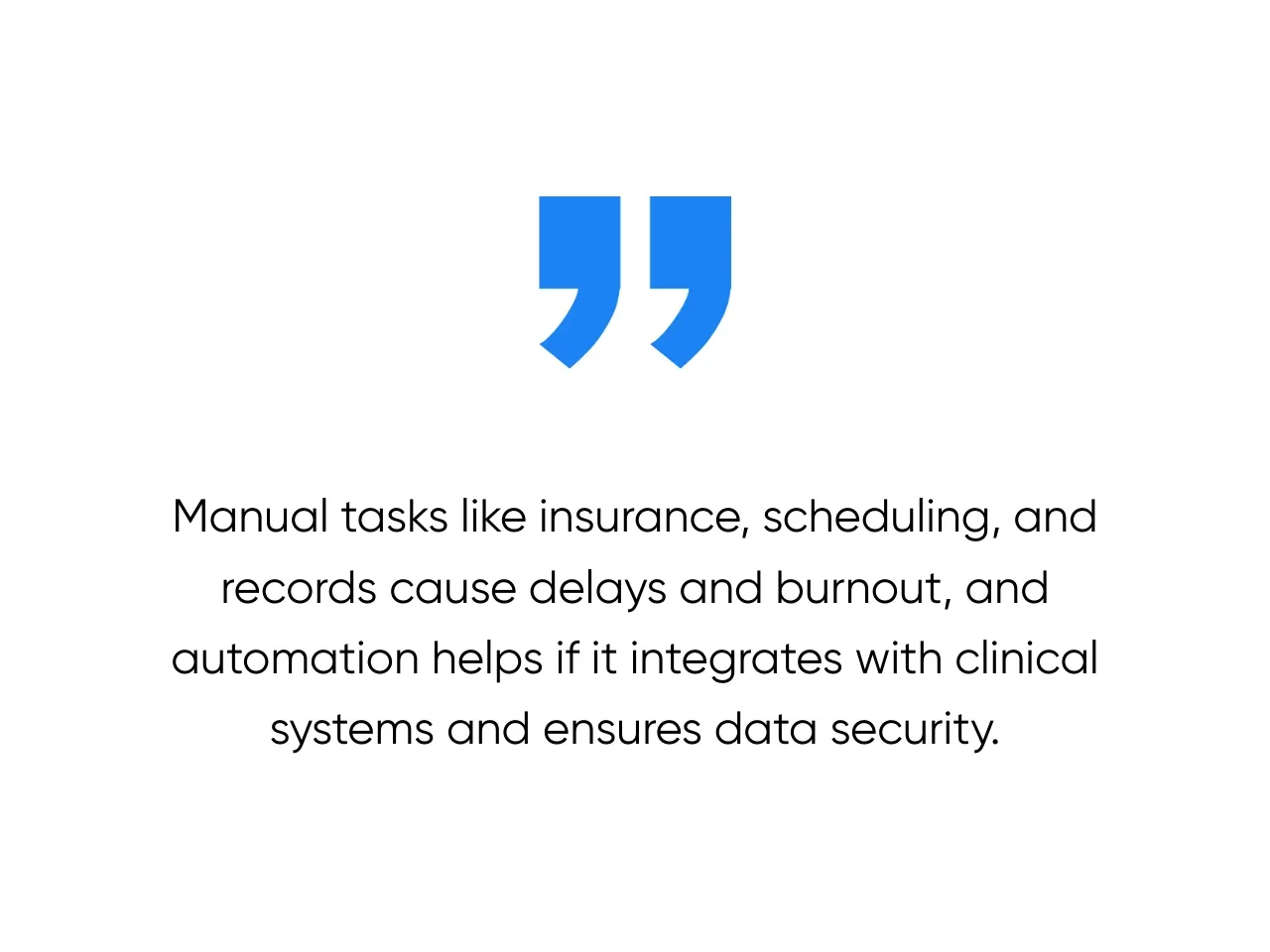
Healthcare organizations work under intense regulatory scrutiny and mounting workload pressures. Staff are expected to handle growing patient volumes while ensuring compliance with strict privacy rules. Manual processes around insurance, scheduling, and records often create delays and burnout. Automation can help, but only if it integrates with clinical systems and maintains airtight data security.
- Compliance and Security Needs: HIPAA would require encryption for patient data, strict role-based access, and audit logs. Vendors should support HIPAA modules and sign Business Associate Agreements.
- Clinical Integration Challenges: Connecting automation with EMR/EHR systems like Epic or Cerner is often difficult due to proprietary formats and slow vendor updates. Clinical workflows may need custom interfaces or HL7/FHIR integrations.
- Workflow Priorities: Patient intake, insurance checks, claims processing, and clinical scheduling are common pain points where errors delay care.
- Platform Fit: UiPath or Automation Anywhere could manage unstructured data from forms; ServiceNow might support IT or patient support requests; low-code tools could assist with scheduling and reminders.
- ROI and Timelines: Many providers aim for 9–15 months to break even. Automating claims and eligibility checks typically shows faster returns.
Instead of staff spending 4–5 minutes per patient verifying insurance coverage at check-in, automation could pre-populate the EMR, which saves hundreds of hours annually and improves patient throughput.
Financial Services
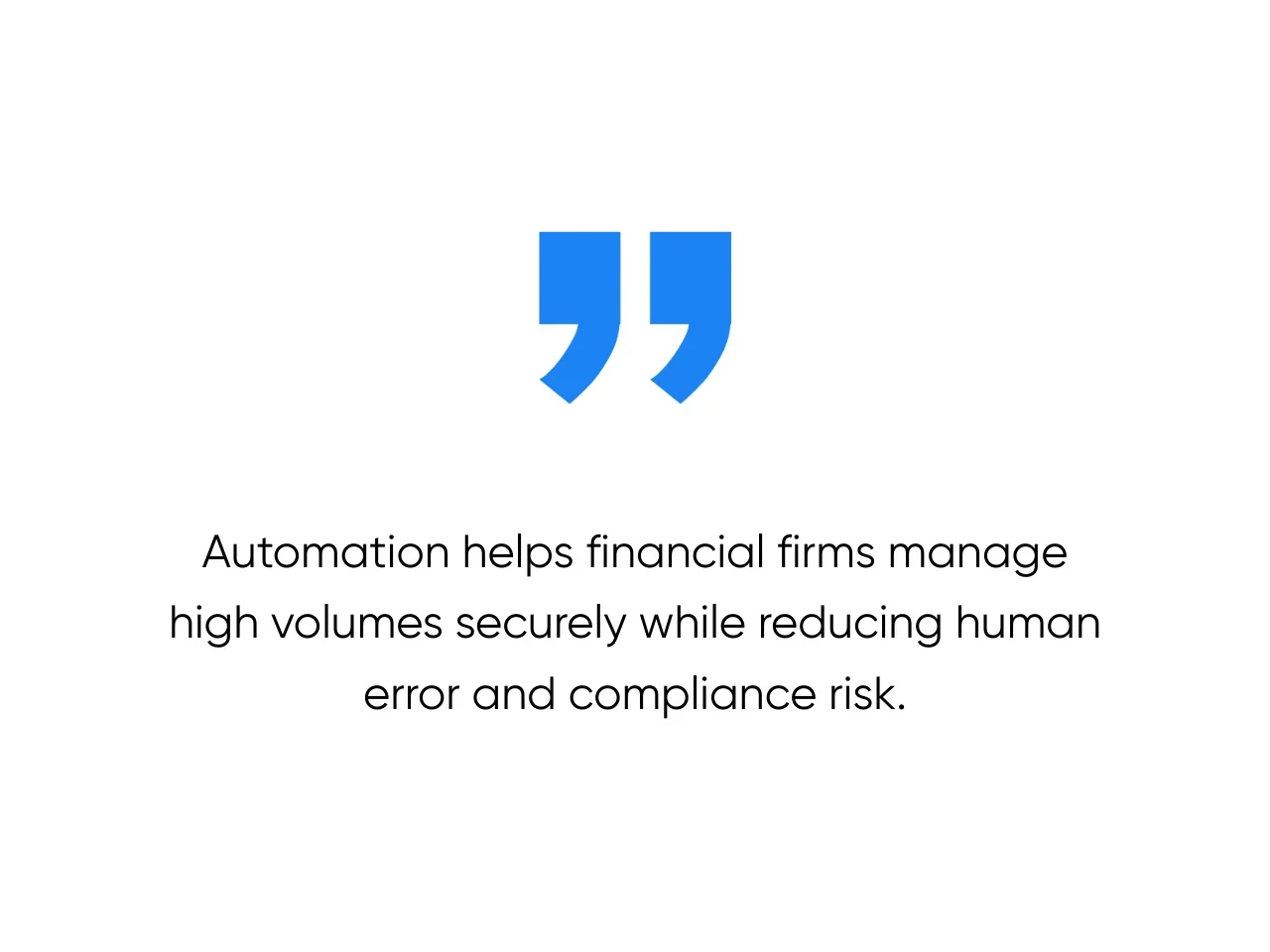
These firms face the dual challenge of heavy regulation and competitive digital-first expectations. Manual KYC checks, fraud monitoring, and compliance reporting slow down onboarding and raise costs. Mistakes don’t just frustrate customers; they can lead to regulatory penalties. Automation allows firms to handle high volumes securely while reducing human error and compliance risk.
- Regulatory Compliance: SOX and PCI-DSS would require encryption, granular access controls, and automatic generation of transaction audit logs for regulator reviews.
- Fraud and Risk Monitoring: Automation can feed and monitor fraud detection models in real time, flagging suspicious activity for analyst review. AML and KYC bots can enhance oversight while reducing manual effort.
- Workflow Priorities: KYC verification, AML monitoring, loan processing, and fraud alert routing are frequent automation candidates.
- Platform Fit: UiPath or Automation Anywhere might handle document-heavy KYC tasks; Power Platform could deliver real-time risk dashboards; ServiceNow might support IT compliance workflows.
- ROI and Timelines: Payback commonly lands within 9–18 months. KYC and loan workflow automation tends to deliver the fastest returns; fraud detection programs may take longer but add significant risk-reduction benefits.
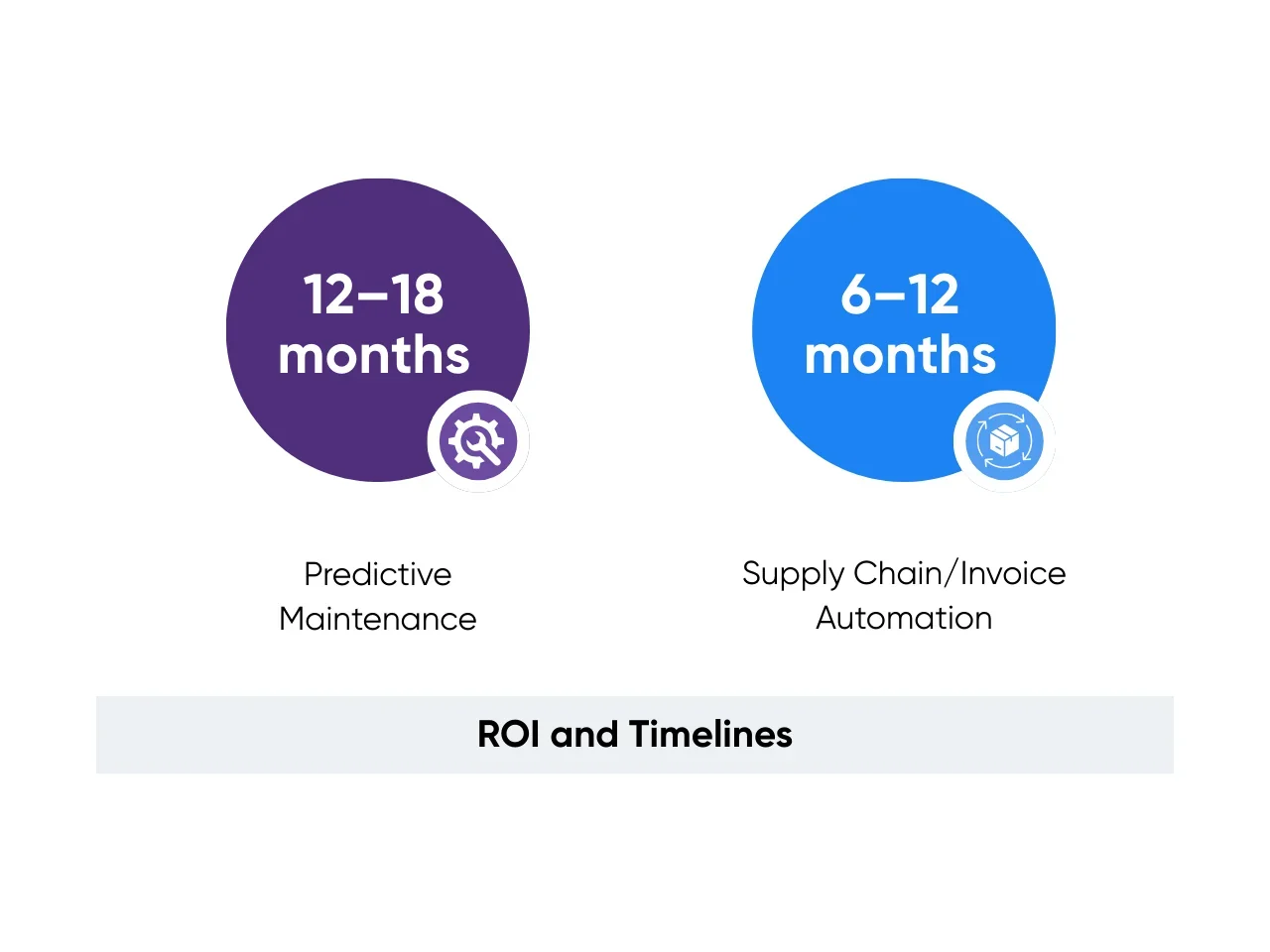
A mid-sized bank could have bots gather and verify IDs and run watchlist checks automatically. If an analyst spends 20 minutes per applicant, automation might cut that to under five, reducing onboarding time and freeing staff to handle complex compliance reviews.
Manufacturing
Manufacturers manage complex supply chains and production lines where delays directly affect revenue. Quality control data often sits siloed, and maintenance is reactive rather than predictive. Automation helps integrate IoT data with ERP and MES systems so teams can act before issues escalate and streamline repetitive back-office work. An AI tool for choosing materials in manufacturing can further enhance decision-making by optimizing material selection based on performance, cost, and availability, reducing waste and improving product quality.
- IoT and Integration: IoT sensor data would need to connect with ERP or MES systems and trigger automated responses in real time.
- Supply Chain Automation: Bots can streamline purchase order matching, vendor onboarding, and shipment tracking to reduce manual coordination.
- Quality Control: Automation can capture, log, and analyze inspection data to flag defects early and support compliance with ISO standards.
- Platform Fit: Power Platform could pair with Dynamics 365 SCM; UiPath might bridge ERP gaps; Automation Anywhere could manage supplier documents and inventory workflows.
- ROI and Timelines: Predictive maintenance and quality initiatives often take 12–18 months; supply chain and invoice automation can break even in 6–12 months.
A plant could use IoT-fed bots to flag abnormal machine readings and schedule service before failure. Avoiding even one major breakdown could save tens of thousands in downtime and keep on-time delivery rates above 95%.
Retail
Retailers live and die by customer experience and operational agility. Seasonal peaks put pressure on support and fulfillment teams. Manual processes can’t keep up with order spikes or provide the fast responses customers expect. Automation supports personalized service and helps operations scale without adding headcount.
- Customer Experience Automation: Chatbots, personalized order status updates, and automated return authorizations can improve customer experience without adding staff.
- Seasonal Scalability: Peak seasons require automation that can handle traffic spikes in orders and support tickets without degrading response times.
- Workflow Priorities: Inventory-level monitoring, order fulfillment notifications, and returns routing are typical early wins.
- Platform Fit: Zapier or other low-code tools could tie e-commerce systems to CRMs; Power Platform might handle inventory analytics; ServiceNow could serve enterprise IT/logistics.
- ROI and Timelines: Chatbots and order routing often pay back in 3–9 months; inventory automation typically takes 6–12 months.
An online retailer might set up a chatbot to handle order status and return FAQs. Deflecting even 25% of repetitive support tickets could save hundreds of agent hours per quarter and speed up customer response during holiday peaks.
Professional Services
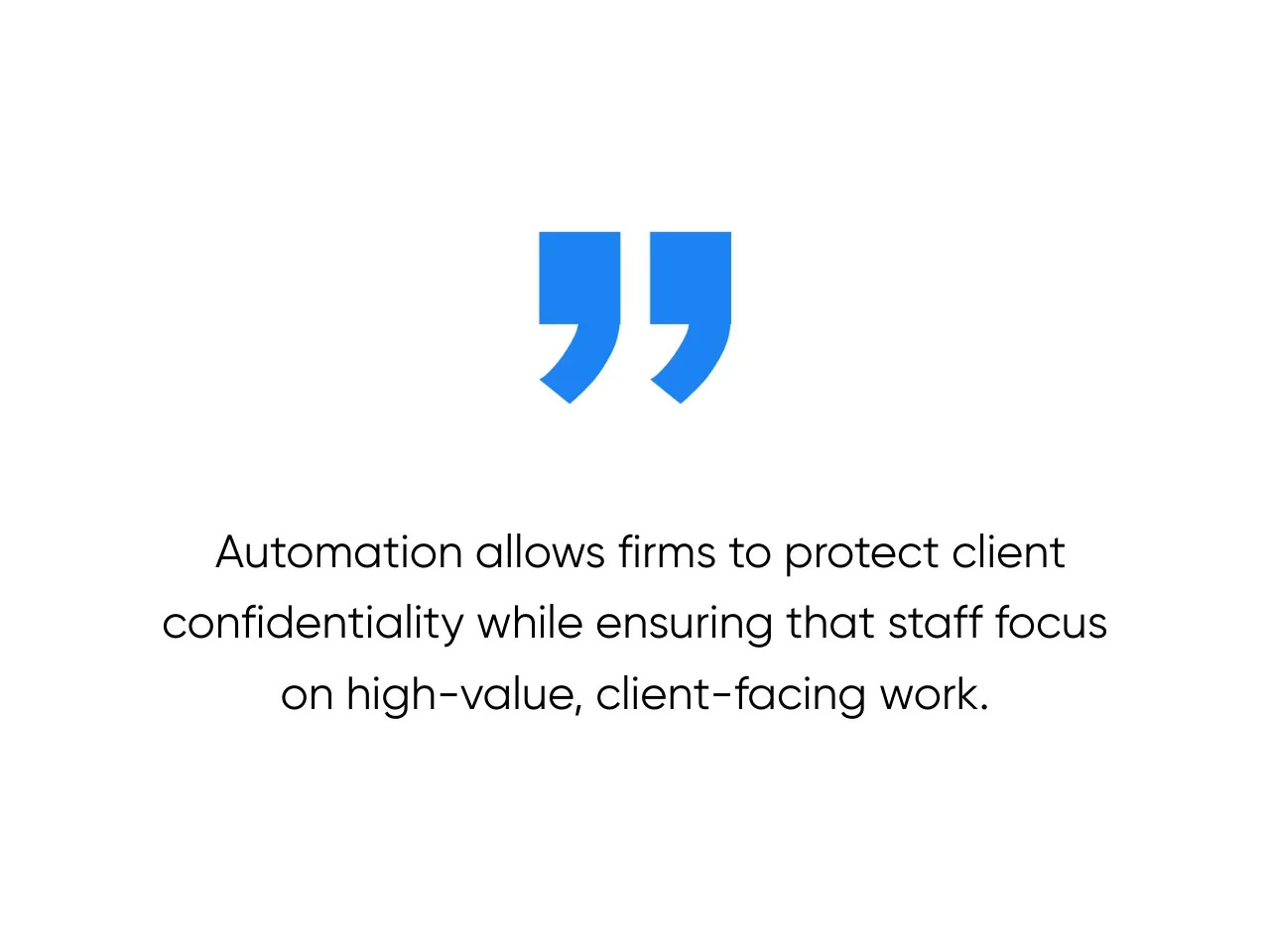
These firms compete on trust and efficiency. Administrative drag in billing, approvals, and project tracking eats into billable time and delays revenue recognition. Automation allows firms to protect client confidentiality while ensuring that staff focus on high-value, client-facing work.
- Client Data Protection: Strict access controls, encryption, and compliance with GDPR or regional laws are required for confidentiality.
- Project Workflow Automation: Automating engagement onboarding, task tracking, and approval flows can improve visibility and reduce missed deadlines.
- Billing and Time Tracking: Bots can sync time entries with billing systems to reduce duplicate entry and speed invoicing.
- Platform Fit: Power Platform or other low-code tools could connect billing and reporting; Zapier might automate light project workflows; ServiceNow could support enterprise PMO needs.
- ROI and Timelines: Payback is often achieved within 6–12 months by reducing admin overhead and accelerating revenue recognition.
If consultants lose several hours monthly to duplicate time logging, automation could reclaim that time for billable work and shorten the billing cycle by days.
Implementation Timeline and Resource Planning
Rolling out automation takes more than picking the right tool. It helps to know how long each step takes, which milestones are worth tracking, and lining up the right people so the project sticks.
Project Planning and Milestone Framework
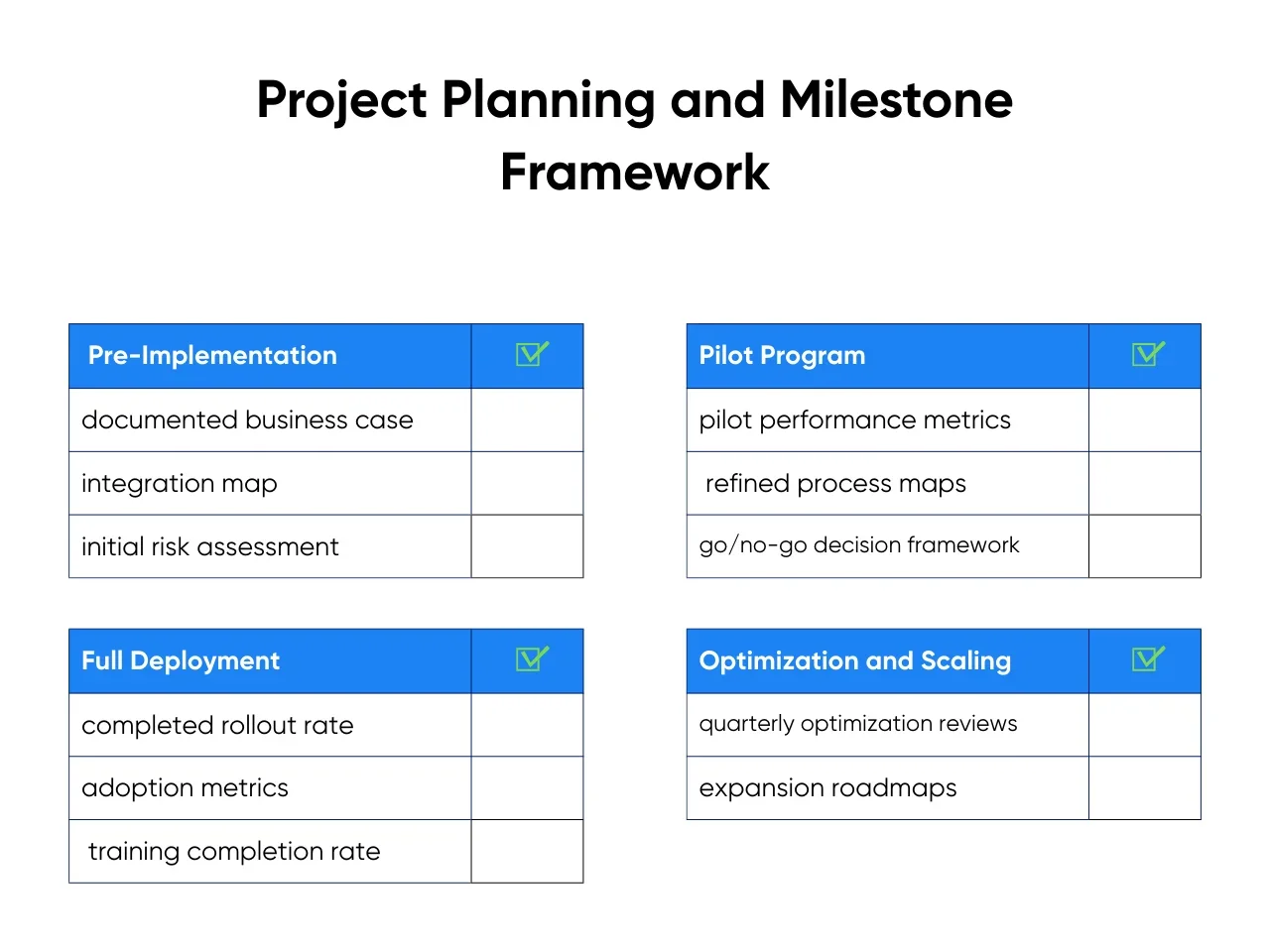
Rolling out automation works best in phases. Jumping straight to full deployment often leads to integration headaches and poor adoption. Teams that set realistic milestones up front tend to see smoother results.
- Pre-Implementation (4–8 Weeks): Gather requirements, audit workflows, and define success metrics. This is the time to shortlist platforms, run vendor demos, and set an internal budget. Assemble your core project team and secure leadership support.
- Pilot Program (6–12 Weeks): Start with one or two high-impact workflows. Configure the platform, connect required data sources, and test with a small group of users. The goal: validate ROI assumptions and surface integration issues before scaling.
- Full Deployment (12–24 Weeks): Roll out in waves, not all at once. Train users in batches, provide documentation, and build feedback loops into the process. Change management and support are non-negotiable here.
- Optimization and Scaling (Ongoing): After launch, keep monitoring performance and refining workflows. Use lessons from the pilot and rollout to identify new automation opportunities. (We’ll dive deeper into monitoring later.)
A mid-sized tech firm might take around nine months from kickoff to full adoption across multiple departments. Starting with a 6-week pilot for invoice processing, then scaling to HR and IT workflows, helps prove value before broader investment.
Team Composition and Skill Requirements
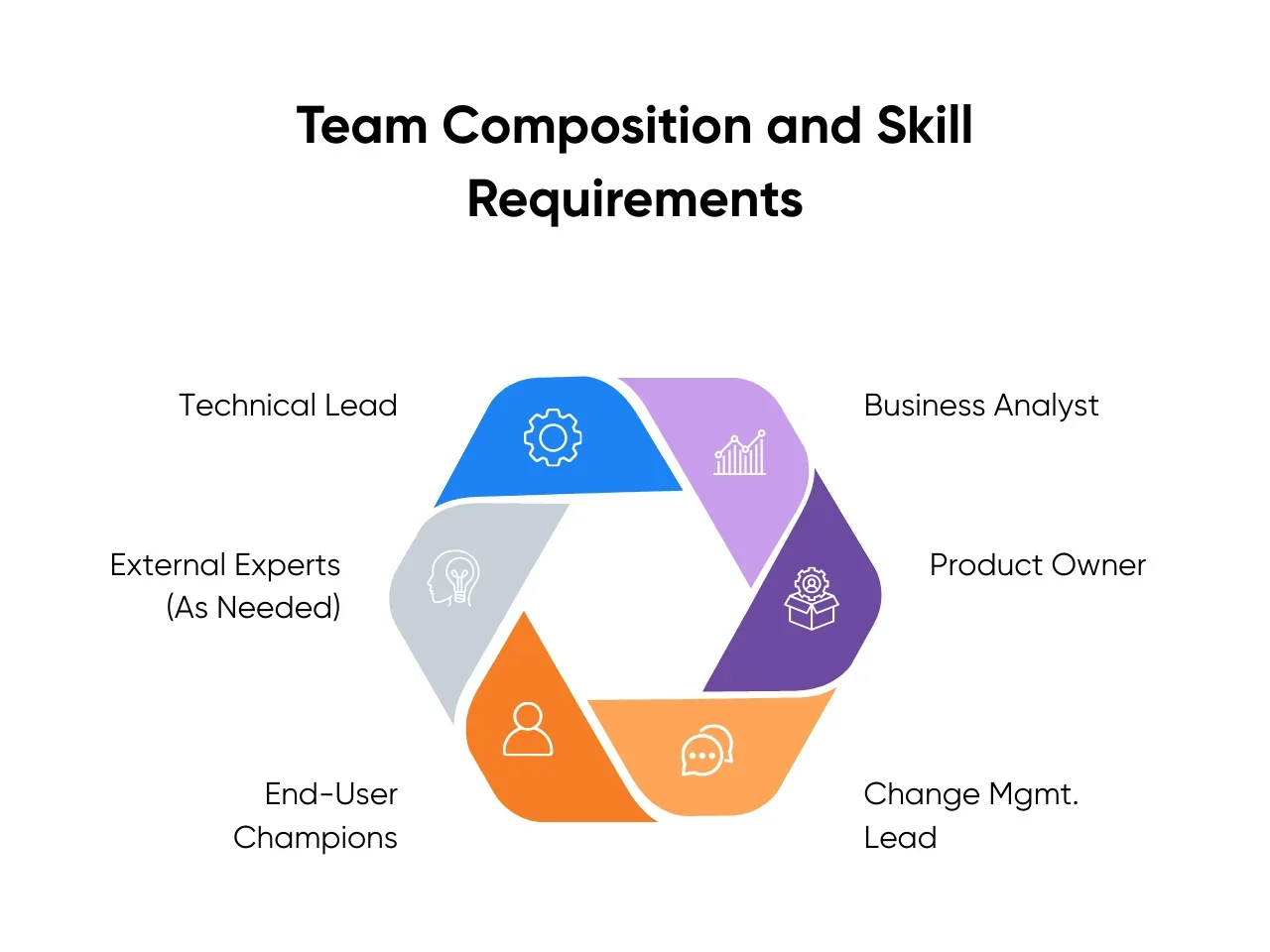
Automation is a team effort. Having the right mix of roles and skills makes the difference between a smooth rollout and months of rework.
- Technical Lead: Owns platform configuration, API integrations, and security reviews. Needs experience with your systems and the chosen tool.
- Business Analyst: Maps workflows, defines ROI metrics, and translates business needs into technical requirements. Acts as the bridge between IT and end users.
- Product Owner: Bridges business goals with technical execution to ensure ROI metrics and requirements stay clear and aligned. Provided by Aloa for every software project in place of the traditional Business Analyst role
- Change Management Lead: Prepares communications, training plans, and feedback loops. Helps prevent adoption resistance and keeps users engaged.
- End-User Champions: Representatives from each affected team. Provide feedback during pilots and advocate for automation among peers.
- External Experts (As Needed): Implementation partners or consultants can fill skill gaps in areas like custom integrations, compliance, or advanced AI modeling.
Expect heavier lifts from your technical lead and analyst/product owner (often 50–70% of their time during rollout). Change leads and champions are closer to 10–30%. Building internal skills pays off long term, but outside help can speed up complex or compliance-heavy projects.
Risk Management and Contingency Planning
Even great plans hit bumps. The trick is spotting the usual suspects early and having a backup plan ready.
- Data Quality Issues: Automation is only as good as the inputs. Budget time for data cleanup and validation. Have fallback manual workflows in place if feeds fail.
- User Adoption Resistance: Lack of training or unclear benefits can sink adoption. Loop users in early, explain “what’s in it for them,” and make support easy to reach.
- Technical Integration Hurdles: API limits, authentication errors, or legacy system quirks often show up in pilots. Build buffer time and have technical SMEs ready to troubleshoot.
Use a simple risk matrix to rank issues by likelihood and impact, and assign owners to each. It’s also smart to earmark 10–15% of your budget for surprises like vendor-side delays or extra integration work.
Performance Monitoring and Optimization Strategies
Long-term ROI depends on tracking the right signals and making steady improvements. Here’s how teams measure performance, keep everyone aligned, and fine-tune workflows so the AI automation platform keeps paying off:
Define and Track Critical KPIs
.webp)
Clear benchmarks make it possible to tell if automation is doing its job and delivering the results you promised. These are the core metrics most teams monitor:
- Processing Speed: Track cycle time improvements compared to the manual baseline. If invoice approvals drop from two days to six hours, that’s a direct productivity gain you can quantify.
- Error Rates: Monitor pre- and post-automation error levels. Many teams see data entry errors fall 20–40% within the first six months, cutting rework costs.
- User Adoption: Measure active users vs. total eligible users. Adoption rates over 70–80% by month six are a good indicator of solid training and user experience.
- Cost Savings Realization: Compare actual labor hours reduced and rework avoided against projections. Well-planned rollouts often realize 15–30% fewer manual hours in year one.
Successful teams set 6-, 12-, and 24-month KPI targets to keep ROI on track and guide future investments.
Build Dashboards and Reporting Cadences
Once you know what to measure, you need a way to share it that makes sense to different audiences. These reporting approaches keep the right people informed without drowning them in data:
- Dashboards: IT and operations teams benefit from real-time dashboards showing queue lengths, job failures, and processing times. This visibility helps spot issues before they snowball.
- Executive Reporting: Business leaders need monthly or quarterly summaries focused on ROI, cost avoidance, and adoption trends. Presenting reduced error rates or hours saved in dollar terms resonates at the leadership level.
- Front-line Feedback: End users benefit from seeing task-level success metrics in their tools. For example, showing ticket routing accuracy or average handling time keeps users engaged and motivated.
Teams that share results consistently often see stronger executive support and faster buy-in for expanding automation programs.
Create Continuous Feedback Loops
Numbers tell part of the story, but user input reveals where automation helps and where it needs work. A few habits help keep feedback flowing and actionable:
- User-to-IT feedback: Provide an easy channel (Slack form, helpdesk ticket type) for users to report errors or suggest tweaks. Capturing this early prevents workflow workarounds from forming.
- Cross-Functional Reviews: Monthly check-ins with IT, analysts, and department leads can identify optimizations that shave minutes off tasks and reduce error rates.
- Executive Oversight: Tie high-level ROI metrics back to company goals in quarterly reviews. Linking automation to outcomes like faster order fulfillment or improved customer NPS scores keeps leadership invested.
For example, if support agents notice a chatbot misunderstanding common requests, their input should feed directly into workflow refinement.
Test and Optimize Workflows Iteratively
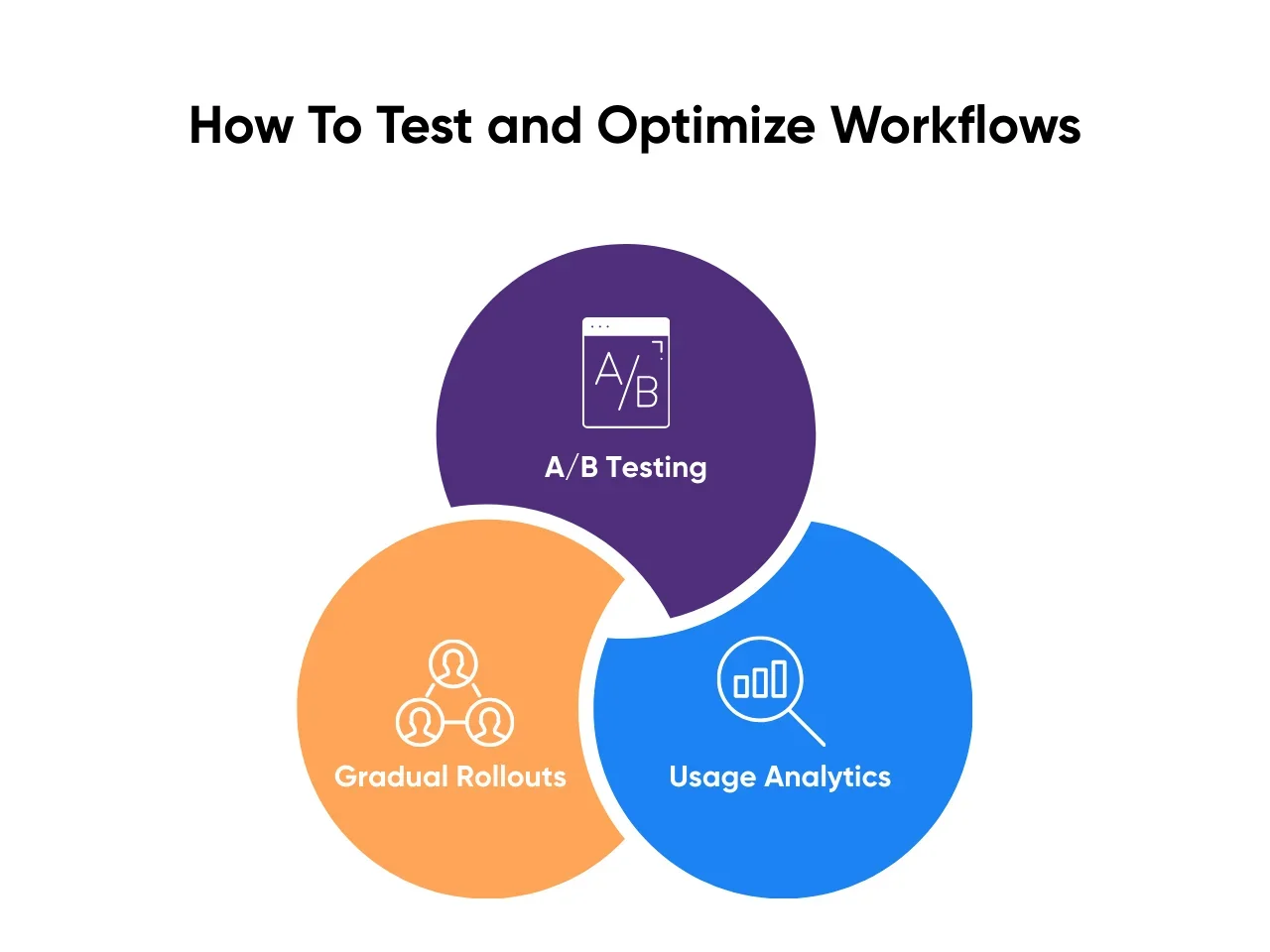
Automation isn’t set-and-forget. Ongoing testing and adjustments keep results from plateauing. Consider these approaches:
- A/B Testing: Test variations in workflow logic or routing rules. One retailer reduced support resolution time by 15% after testing two routing methods and rolling out the faster option.
- Usage Analytics: Track where users drop off or workflows fail. A spike in abandoned tasks often highlights a confusing step or broken integration.
- Gradual Rollouts: Pilot optimizations with a small group before deploying company-wide to avoid disruption.
Teams that review workflows quarterly and run controlled tests often see double-digit efficiency gains year over year.
Schedule Regular Platform Reviews and Upgrades
Your business changes, and so do automation platforms. Ongoing reviews keep workflows relevant and prevent costly slowdowns:
- Quarterly Reviews: Revisit workflows and KPIs to identify redundant steps. Many teams free up another 5–10% of process time each year through these small refinements.
- Annual Vendor Evaluation: Check for platform updates, new integrations, or pricing changes. Leveraging new built-in connectors can replace custom scripts and save thousands annually.
- Capacity Planning: Ensure infrastructure and licenses can handle load as adoption grows. Addressing this early prevents slowdowns during peak seasons and avoids costly emergency fixes.
Companies that build reviews into their routine often sustain adoption above 80% and maintain or improve ROI into years two and three, instead of seeing it taper off after the initial rollout.
Troubleshoot Performance Degradation
A clear troubleshooting plan makes it easier to fix problems before they disrupt operations:
- Identify the Source: Use monitoring dashboards to pinpoint issues. Data schema changes, API limits, or system updates are common culprits.
- Escalation Paths: Define who investigates and resolves each issue (internal vs. vendor). This avoids finger-pointing and saves time.
- Prevent Recurrence: Document fixes and update runbooks. Build alerts for recurring failure patterns.
For example, if invoice bots slow after an ERP upgrade, a quick root cause analysis can reveal schema changes. Building automated alerts for those errors helps minimize downtime next time.
Common AI Implementation Pitfalls
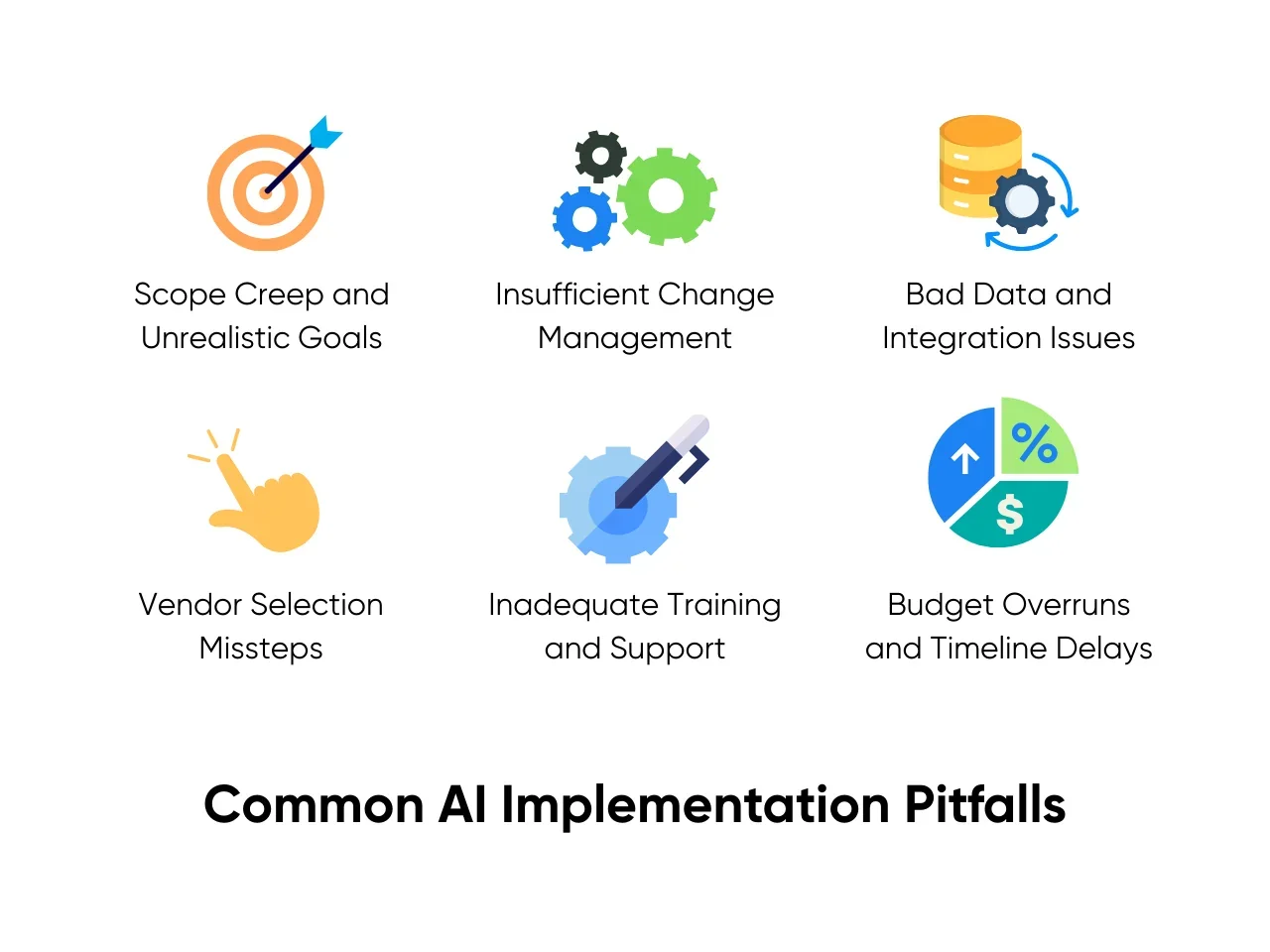
Some studies put failure or stalled adoption rates as high as 70–85%. But most of those failures share predictable causes you can tackle early. Here are the traps AI automation projects run into most often:
- Scope Creep and Unrealistic Expectations: Trying to automate everything out of the gate is one of the quickest ways to blow timelines and budgets. Without firm boundaries, “let’s automate it all” turns into endless add-ons. A chatbot pilot meant to handle support tickets can suddenly get saddled with sales workflows, and suddenly launch dates slip.
- Insufficient Change Management: Fear and confusion kill AI adoption fast. Employees disengage if they feel blindsided or worry their jobs are on the line, or if they don’t understand how automation affects their day-to-day.
- Poor Data Quality and Integration Issues: Automation is only as good as the data it runs on. Messy or siloed data and last-minute integration surprises can blow up ROI and trust. It’s not uncommon to discover mid-rollout that key records are incomplete, forcing manual cleanup and delays.
- Vendor Selection Missteps: A slick demo isn’t proof that a platform fits your world. Teams sometimes pick based on hype or price without digging into compliance, scale, or usability. That’s how you end up locked into a three-year contract with a tool that can’t meet your needs.
- Inadequate Training and Support: Without ongoing education, even the most excited users drift off. Usage often drops months after launch if nobody knows where to get help or workflows change quietly.
- Budget Overruns and Timeline Delays: Hidden costs and shifting timelines can sink a project just as fast as tech misfires. Many teams underestimate integration work or keep expanding scope midstream, only to see budgets buckle and deadlines slide.
Tech leaders often lean on partners like Aloa to design and run structured proof-of-concept projects. This approach tests platforms against your actual data and integration points before you commit, reducing the risk of expensive mismatches later.
Avoiding these pitfalls protects your timeline, budget, and credibility. We dug into six costly mistakes in our AI Implementation in Business guide and shared practical frameworks and examples to help you avoid them.
Key Takeaways
Picking an AI automation platform feels high-stakes for a reason. You’re weighing ROI promises against integration headaches, all while trying to keep what already works running. But there’s a way to make it manageable. When you combine a clear ROI framework with honest integration checks, realistic timelines, and a plan for getting your team on board, the chances of success go way up.
You’ve now got the playbook to make an informed call instead of rolling the dice. Define what success looks like, start small, prep your data, and bring the right people along for the ride.
And if you’re ready to go from comparing platforms to seeing results, Aloa can help. We build and integrate custom AI agents and solutions around your workflows, handle the heavy technical lifting, and stick around to make sure the ROI shows up.
Let’s chat about how to roll this out in a way that fits your business and proves its value fast. The teams that move with intention now will be the ones setting the pace later.

